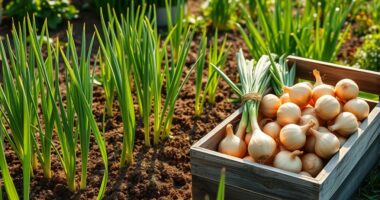To successfully grow cacti at home, I’ve found that using the right soil mix, like Miracle-Gro Cactus, Palm & Citrus Potting Mix, is essential. I water every 10 to 14 days, letting the soil dry out fully between waterings. Proper lighting is key, so I position my cacti where they get at least six hours of sunlight daily. Plus, I fertilize during the growing season. If you want more valuable tips and insights, you won’t want to miss what’s coming next!
Key Takeaways
- Use Miracle-Gro Cactus, Palm & Citrus Potting Mix for excellent drainage and to prevent root rot in your cacti.
- Water every 10 to 14 days during the growing season, allowing soil to dry completely between waterings.
- Ensure cacti receive at least six hours of direct sunlight daily to prevent etiolation and promote healthy growth.
- Apply Succulent Plant Food every two weeks during the growing season for optimal nutrient supply to your cacti.
- Monitor temperatures; keep cacti in a range of 70°F to 100°F during the day and above 50°F at night.
Miracle-Gro Cactus, Palm & Citrus Potting Mix and Succulent Plant Food Bundle
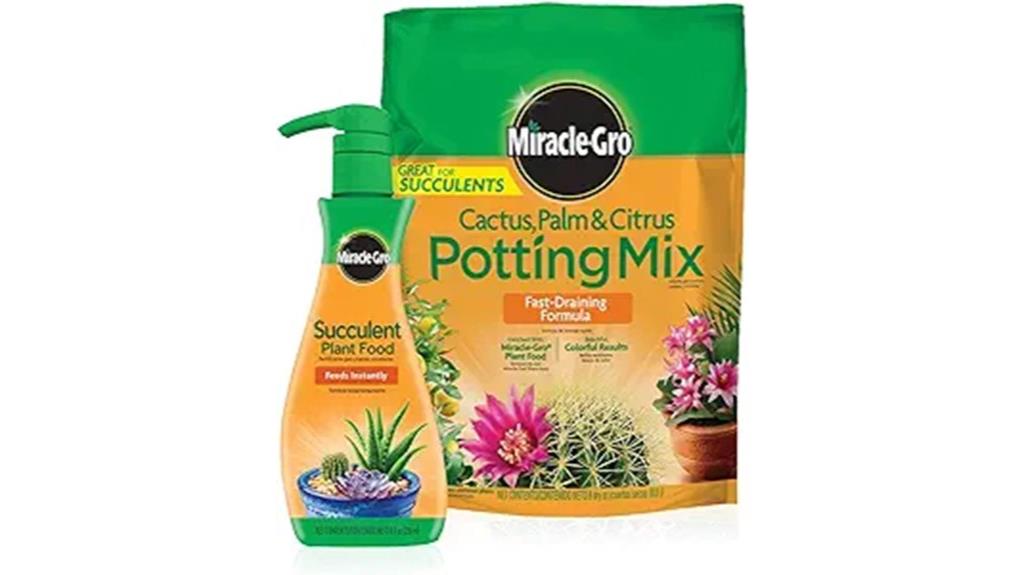
If you’re looking to cultivate vibrant indoor succulents, the Miracle-Gro Cactus, Palm & Citrus Potting Mix and Succulent Plant Food Bundle is just what you need. This specially formulated mix offers excellent drainage with its blend of forest products, sand, and perlite, preventing soil compaction. I love that it’s designed for a variety of plants, including cacti, jade, and aloe. Every two weeks, I apply the succulent plant food directly to the soil or mix it with water, giving my plants the nutrients they crave. With a 4.7-star rating, many others have found success with this bundle too!
Best For: Indoor plant enthusiasts looking to care for cacti, palm, citrus, and succulents with a specially formulated potting mix and nutrient-rich food.
Pros:
- Excellent drainage due to the combination of forest products, sand, and perlite, preventing soil compaction.
- Easy to use with nutrient application every two weeks, either directly or mixed with water.
- Highly rated by customers for improving plant health and vitality.
Cons:
- Some users have reported issues with product quality, such as the presence of rocks in the mix.
- Availability may vary, affecting accessibility for potential buyers.
- Limited to specific types of plants, which may not suit all gardeners’ needs.
The Practical Illustrated Guide to Growing Cacti & Succulents
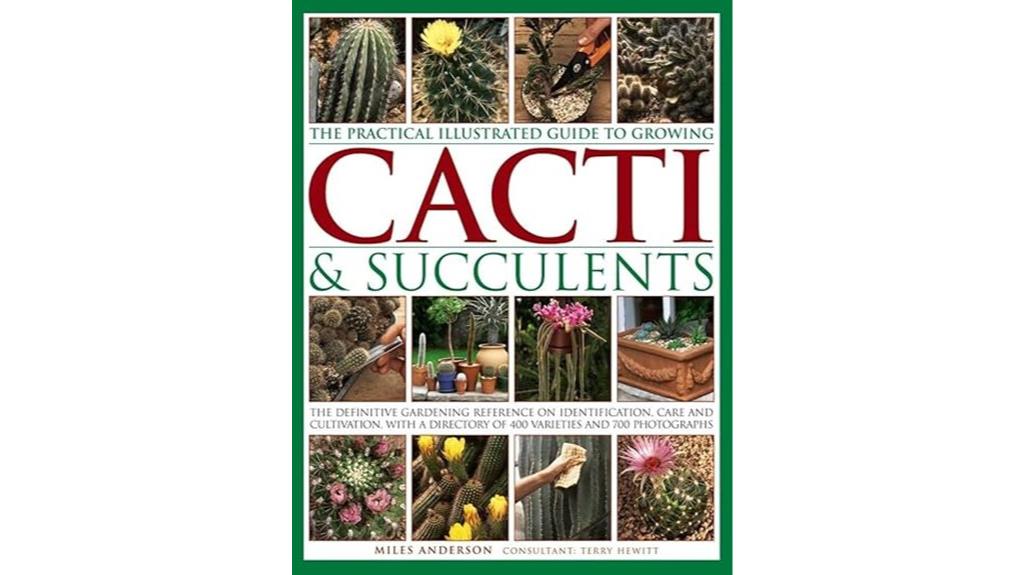
For anyone enthusiastic to plunge into the world of cacti and succulents, *The Practical Illustrated Guide to Growing Cacti & Succulents* stands out as an essential resource. This book is a treasure trove, featuring a directory of 400 varieties and 700 stunning photographs that make identification a breeze. I appreciate the author’s clear, approachable writing style, which makes complex information easy to digest. While the small print can strain my eyes, the visuals help immensely. However, casual gardeners might find it a bit too detailed for their needs. Overall, it’s a fantastic guide for both novices and enthusiasts alike.
Best For: This book is best for gardening enthusiasts and specialists interested in identifying and cultivating a wide variety of cacti and succulents.
Pros:
- Extensive directory featuring 400 varieties supported by 700 high-quality photographs for easy identification.
- The author’s clear and approachable writing style makes complex information accessible to readers.
- Excellent visual quality enhances the learning experience and aids in understanding various species.
Cons:
- Small print size may cause eye strain for some readers, detracting from the overall experience.
- Casual gardeners may find the detailed content too overwhelming for their needs.
- Lack of common names alongside scientific names can complicate identification for those familiar with everyday terminology.
HOME GROWN Succulent & Cactus Seed Kit for Planting
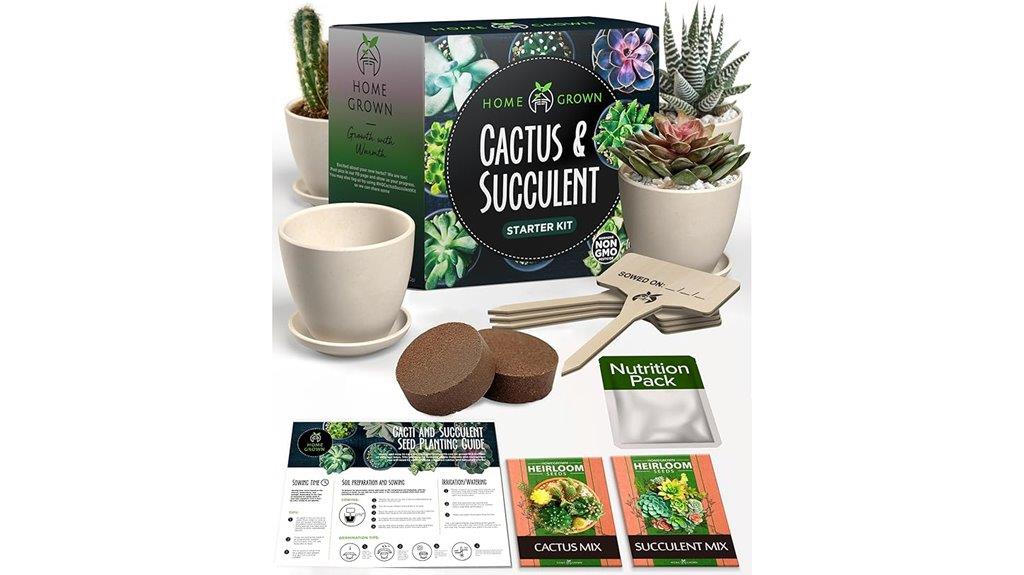
The HOME GROWN Succulent & Cactus Seed Kit is perfect for anyone enthusiastic to plunge into the world of gardening, whether you’re a novice or an experienced enthusiast. This kit includes everything you need: four planters, drip trays, markers, seed mix, peat soil, and a perlite pouch. It even comes with kelp for fertilization and detailed instructions. I love how it offers a complete gardening experience without extra shopping. Plus, these resilient plants can thrive in various spaces, bringing joy indoors or outdoors. Just keep an eye on the instructions, as some feedback suggests clearer guidance could help improve your experience.
Best For: Gardening enthusiasts and beginners looking for a comprehensive and convenient planting experience.
Pros:
- Complete Kit: Includes all necessary items for planting, eliminating the need for extra shopping.
- Versatile: Suitable for indoor and outdoor environments, enhancing any space with greenery.
- Resilient Plants: The seeds are tolerant to drought and excess water, ensuring longevity and ease of care.
Cons:
- Mixed Experiences: Some users reported missing items or challenges with germination.
- Instruction Clarity: Feedback suggests that clearer guidance on fertilizer use and soil management could improve the experience.
- Setup Challenges: A few users found the initial setup process to be less straightforward than expected.
Cactus Succulent Seed Starter Kit for Indoor Gardening

Looking to immerse yourself in indoor gardening? The Cactus Succulent Seed Starter Kit is perfect for you! It comes with four packets of non-GMO seeds, including Mesembryanthemum and Gymnocalycium, along with soil disks, burlap grow bags, and even pruning shears. I love that it includes access to gardening experts and resources like instructional videos. The kit’s thoughtful design makes it a fantastic gift, too. While some users faced germination issues, the majority rave about its quality and user-friendly instructions. If you follow the care guidelines, you’ll be well on your way to cultivating beautiful indoor cacti and succulents!
Best For: Novice to experienced gardeners looking to cultivate indoor cacti and succulents with a comprehensive seed starter kit.
Pros:
- Non-GMO and heirloom seeds ensure high-quality germination.
- Includes access to gardening experts and a community for support.
- Attractive packaging makes it an ideal gift for gardening enthusiasts.
Cons:
- Some users report challenges with seed germination.
- Occasional mold issues due to moisture control difficulties.
- Requires careful adherence to care guidelines for best results.
Cacti and Succulent Handbook, Expanded 2nd Edition
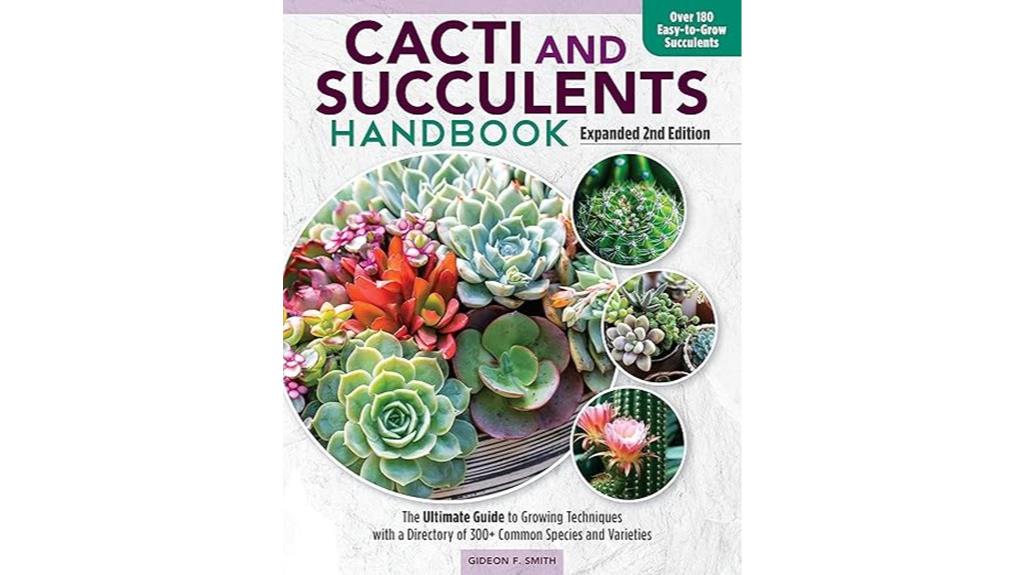
If you’re enthusiastic to expand your knowledge of cacti and succulents but don’t need an exhaustive care guide, the “Cacti and Succulent Handbook, Expanded 2nd Edition” might be just what you’re after. This book serves as a professional guide, featuring over 300 species and stunning photos. While it covers cultivation, handling, and common pests, some readers find the care sections a bit lacking, especially for succulents. It’s excellent as a reference for plant identification, but if you’re a beginner seeking detailed care advice, you might want to look elsewhere. Still, I appreciate its value as an informative resource.
Best For: Enthusiasts looking for a reference guide on cacti and succulents rather than an exhaustive care manual.
Pros:
- Well-constructed with stunning photos and a clear writing style.
- Comprehensive directory of over 300 common species and varieties.
- Serves as a useful reference for plant identification.
Cons:
- Minimal sections on care and handling, disappointing some readers.
- Primarily focuses on cacti, with limited information on succulents.
- Not ideal for beginners seeking detailed care instructions.
SANSI Grow Lights for Indoor Plants

For indoor gardeners seeking to nurture their cacti, SANSI Grow Lights are an excellent choice due to their full spectrum lighting that mimics natural sunlight. With a 5W output, these lights enhance plant growth by 25% while saving 50% on energy compared to similar options. The flexible gooseneck and pot clip design make positioning a breeze, whether on your desk or plant stand. Plus, the built-in timer and dimming function let you customize light exposure easily. I’ve noticed remarkable improvements in my cacti’s health, especially during the darker months. If you’re serious about indoor gardening, consider SANSI for peak results.
Best For: Indoor gardeners who want to enhance plant growth, particularly in low-light conditions.
Pros:
- Full spectrum lighting mimics natural sunlight, promoting optimal plant growth.
- Energy-efficient design saves 50% on power usage compared to similar grow lights.
- Adjustable timer and dimming settings allow for customized light exposure.
Cons:
- Limited to indoor use, not suitable for outdoor gardening.
- Requires a power outlet, which may limit placement options.
- Some users may prefer higher wattage for larger plants or spaces.
Cactus Seed Mix – 50+ Assorted Cacti Seeds for Planting
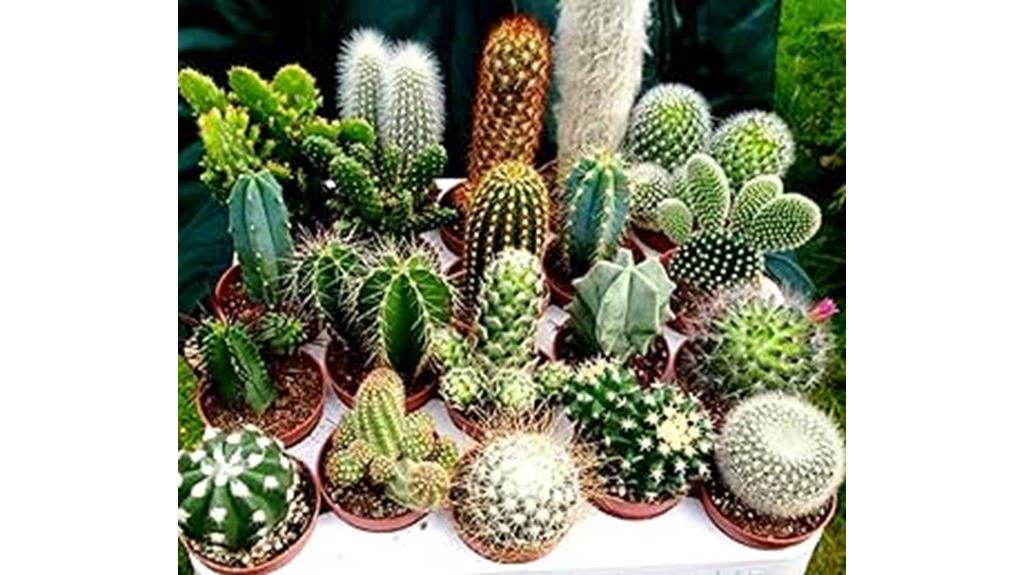
Cacti enthusiasts and novice gardeners alike will appreciate the Cactus Seed Mix, which offers over 50 assorted seeds perfect for both indoor and outdoor planting. This mix includes exotic perennials, showcasing various shapes and forms, with heights ranging from 1.5 to 8 inches. I’ve found that these seeds thrive in sunny, warm spots with fast-draining sandy soil. Watering once every ten days works well, but I ramp it up to twice a week during spring and summer. Most importantly, expect vibrant blooms in spring and summer, making this mix a delightful addition to any garden!
Best For: Cacti enthusiasts and novice gardeners looking to cultivate a diverse range of cacti indoors or outdoors.
Pros:
- GMO-free seeds that promote healthy, natural growth.
- A vibrant mix of exotic perennials that offer unique shapes and sizes.
- Suitable for a range of USDA Hardiness Zones, making them versatile for different climates.
Cons:
- Lack of individual seed packaging may hinder identification of specific varieties.
- Some users report low germination rates for certain seeds.
- Average customer rating of 3.5 stars indicates mixed user experiences.
The Complete Illustrated Guide to Growing Cacti & Succulents
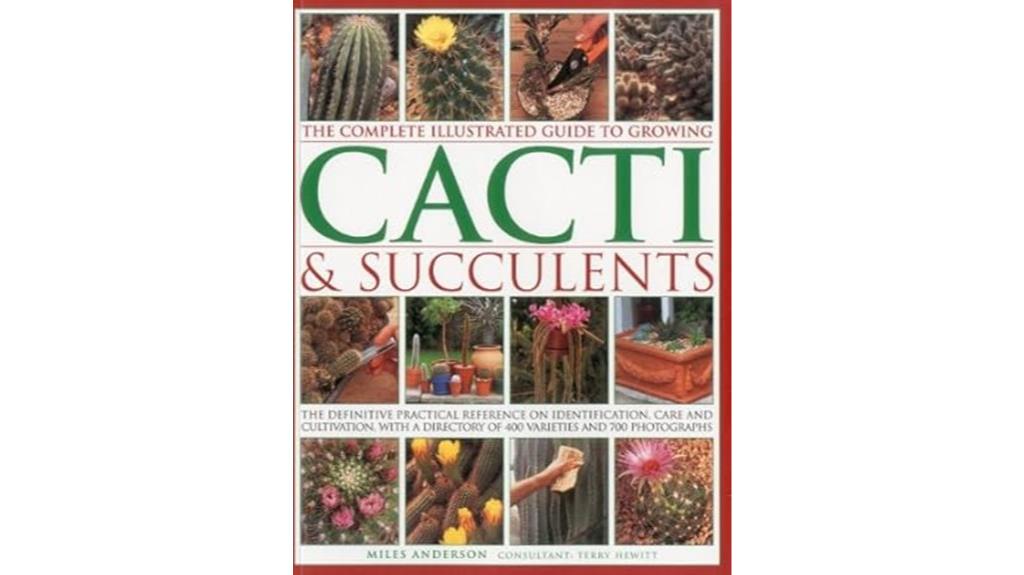
One of the standout features of “The Complete Illustrated Guide to Growing Cacti & Succulents” is its extensive visual appeal, making it an ideal choice for those who thrive on visual learning. The book boasts stunning color photographs and detailed descriptions that help with plant identification. It covers everything from basic care to propagation and pest management, catering to both beginners and seasoned growers. While some content might challenge novices, the practical tips on substrate setup and maintenance are invaluable. Overall, it’s a fantastic resource for anyone enthusiastic to immerse themselves in the fascinating world of cacti and succulents.
Best For: This book is best for both novice and experienced growers seeking a comprehensive resource on cacti and succulents.
Pros:
- High-quality illustrations and stunning color photographs aid in plant identification.
- Comprehensive coverage of growing techniques, propagation, and pest management.
- Practical tips on substrate setup and maintenance are invaluable for hobbyists.
Cons:
- Some content may be too technical for beginners, potentially causing confusion.
- The print size is noted as too small, making reading uncomfortable for some.
- It duplicates content from a previous publication, which may not provide new information for some readers.
Juhefa Grow Light for Indoor Plants
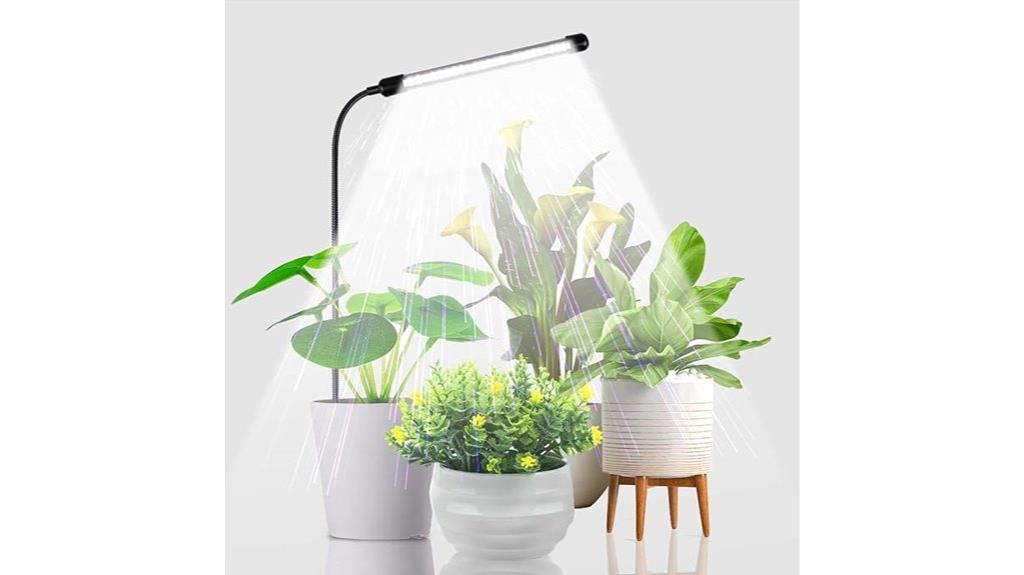
If you’re looking to enhance your indoor gardening experience, the Juhefa Grow Light is an excellent choice. This light mimics natural daylight with its 6000K full spectrum, making it perfect for cacti and other indoor plants. I love the 5 levels of dimming, which help save electricity while providing the right brightness for my plants. The auto on/off timer is a game-changer for ensuring they get ideal light and rest. Plus, the 360° gooseneck design makes it easy to adjust. Overall, it’s a durable and affordable option that’s really helped my indoor gardening thrive.
Best For: Indoor gardening enthusiasts looking for supplemental lighting during colder months when natural light is insufficient.
Pros:
- Versatile design with a 360° gooseneck for easy angle adjustment.
- Energy-efficient with 5 levels of dimming to match plant light needs and save electricity.
- Auto on/off timer feature ensures optimal light absorption and rest periods for plants.
Cons:
- Some concerns about the flexibility of the arm, which may affect positioning.
- Reports of inconsistency in manufacturing quality, leading to varying user experiences.
- May require sturdy pots for stability when used in certain setups.
Kew Gardeners Guide to Growing Cacti and Succulents
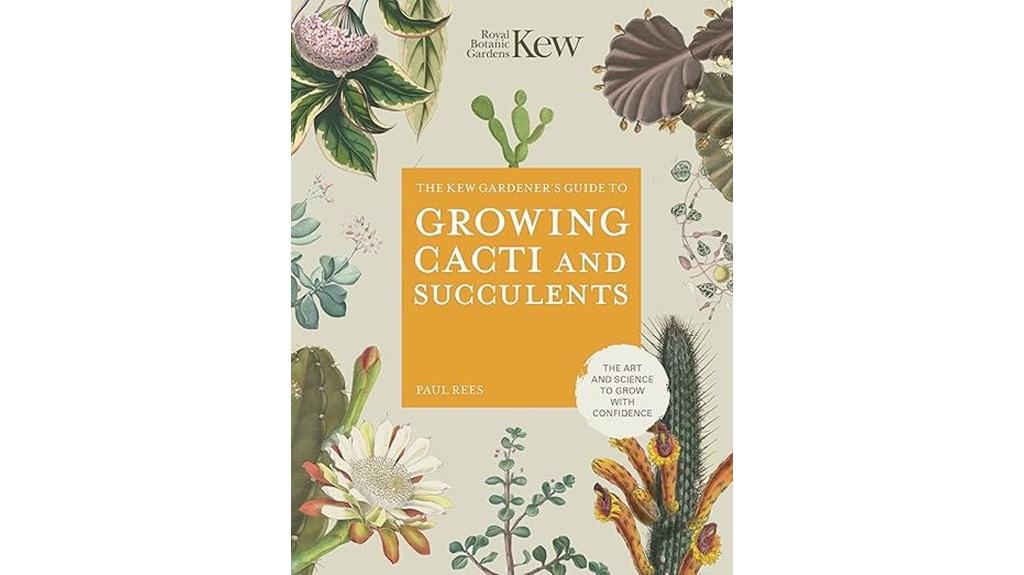
For anyone starting their journey into the world of succulents and cacti, “The Kew Gardeners Guide to Growing Cacti and Succulents” is an excellent resource. This compact book, spanning 144 pages, offers handy tips on caring for various succulents, watering, and propagation techniques. While it features charming vintage illustrations, I found the lack of real photos a bit disappointing. The index could use improvement, as I experienced some confusion when searching for specific plants. Despite that, it’s a worthwhile read for beginners and a lovely introduction to these fascinating plants. Give it a try—it’s a light, enjoyable guide!
Best For: Beginners and enthusiasts looking for a light and accessible guide to caring for succulents and cacti.
Pros:
- Provides handy tips on care, watering, and propagation techniques for various succulents.
- Features charming vintage illustrations that add an aesthetic appeal to the content.
- Serves as a good introductory resource for those new to succulent gardening.
Cons:
- Lacks real photos for all plants, which may disappoint some readers seeking visual references.
- The index is inaccurate, leading to potential confusion when searching for specific plants.
- Some content may appear outdated or not provide new information for seasoned succulent scholars.
Succulent Cactus Seed DIY Terrarium Starter Kit
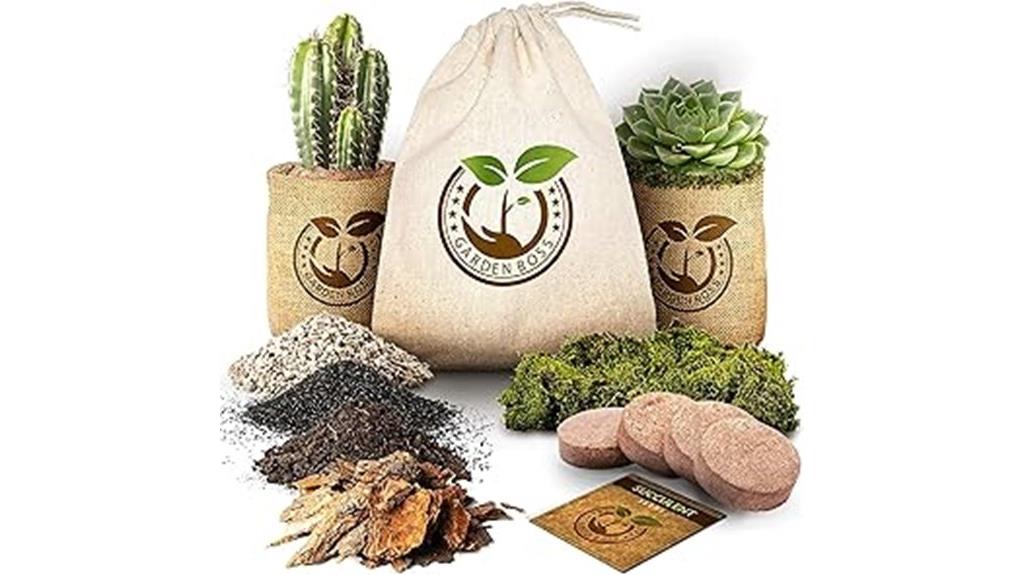
The Succulent Cactus Seed DIY Terrarium Starter Kit is perfect for anyone enthusiastic to immerse themselves in the world of indoor gardening. This kit includes everything you need: succulent seeds, peat discs, burlap pot bags, and even decorative elements like cacao shells and reindeer moss. I love how the burlap bags have drainage holes, making them practical for indoor use. Just remember, the seeds can take up to 60 days to sprout, so patience is key! It’s a charming gift option too, though some users noted issues with missing seeds. Overall, it’s a fun way to start your succulent journey!
Best For: Anyone looking to start an indoor garden with succulents or as a thoughtful gift for gardening enthusiasts.
Pros:
- Includes all necessary components for creating a terrarium, making it a convenient starter kit.
- Burlap pot bags feature drainage holes, ensuring proper water management for indoor plants.
- Fun and engaging project that can be enjoyed by both beginners and experienced gardeners.
Cons:
- Some users reported missing primary seeds, which can hinder the gardening experience.
- Plants may not grow as expected, leading to disappointment for some customers.
- Directions may be vague, leaving users uncertain about specific planting or care instructions.
Back to the Roots Organic Succulent & Cacti Mix (6 Quart)
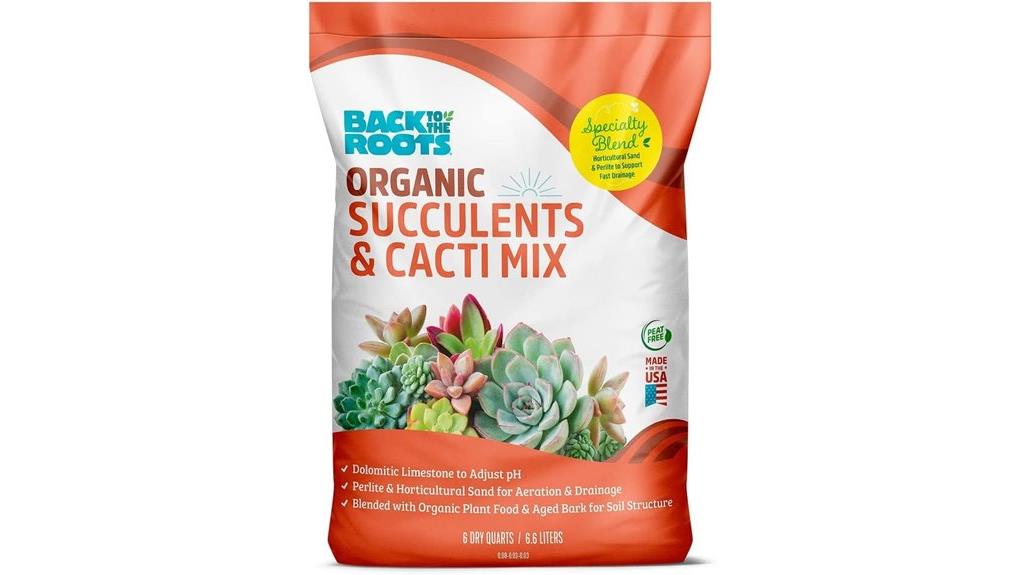
Looking to create the perfect environment for your cacti and succulents? I highly recommend the Back to the Roots Organic Succulent & Cacti Mix. This 100% organic blend, made in the USA, offers an ideal nutrient balance, thanks to its aged bark, perlite, and horticultural sand for excellent drainage. I’ve found it promotes strong root growth while retaining moisture without becoming waterlogged. Plus, it’s lightweight and perfect for repotting. With a 100% satisfaction guarantee, you can’t go wrong. Just keep in mind to add organic fertilizer a month after transplanting for best results!
Best For: Those looking to create an optimal growing environment for succulents and cacti, whether indoors or outdoors.
Pros:
- Promotes strong root growth and resilience in plants.
- Lightweight and easy to handle, making repotting a breeze.
- 100% satisfaction guarantee with growth assurance.
Cons:
- Some users reported the presence of mushrooms due to organic content.
- Occasional quality issues with darker, moister batches noted.
- May require the addition of organic fertilizer a month after transplanting for best results.
Factors to Consider When Choosing Cactus Growing

When I choose cacti for my home, I always consider the specific needs of each plant. Factors like soil type, light exposure, and watering schedules can make a big difference in their health. I’ve learned that paying attention to temperature and fertilization practices is just as essential for thriving cacti.
Soil Type Selection
Choosing the right soil for your cacti is vital for their health and growth. I’ve found that cacti thrive in fast-draining soil, which prevents root rot. A mix of sand, perlite, or horticultural grit works wonders. Aim for a soil pH between 6.0 and 7.0 to guarantee healthy growth and nutrient absorption. Adding organic components like aged bark can really enhance soil structure and aeration, promoting robust root development. It’s important to avoid heavy, moisture-retaining soils, as they can lead to waterlogged conditions that harm your cacti. After planting or transplanting, I recommend incorporating organic fertilizers to optimize nutrient availability, helping your cacti flourish in their new home. Happy planting!
Light Requirements
After ensuring your cacti have the right soil, the next factor to take into account is their light requirements. Cacti thrive best in full sun, needing at least six hours of direct sunlight daily. Without enough light, they can become elongated and weak, a condition known as etiolation. If you’re growing cacti indoors, consider using supplemental lighting, especially during the darker winter months. But be cautious—too much direct sunlight can scorch your plants, particularly in very hot climates. Remember, different cactus species have unique light needs; while some love full sun, others prefer partial shade. It’s crucial to understand the specific requirements of your cactus types to help them flourish. Happy growing!
Watering Schedule
A well-planned watering schedule is essential for keeping your cacti healthy and thriving. During the growing season in spring and summer, I water my cacti every 10 to 14 days. In contrast, I reduce it to once a month during their dormancy in fall and winter. It’s vital to let the soil dry out completely between waterings to avoid root rot, as cacti thrive in dry conditions. I also consider factors like humidity, temperature, and the specific type of cactus. I keep an eye out for signs of overwatering, like yellowing or mushy stems, and underwatering, which can make my plants shrivel. Using well-draining soil and pots with drainage holes helps maintain a healthy watering routine.
Temperature Conditions
When it comes to temperature conditions for growing cacti, I find that maintaining the right range is essential for their health. Cacti thrive in warm temperatures, ideally between 70°F to 100°F (21°C to 38°C) during the day and not dropping below 50°F (10°C) at night. I’ve learned that consistent exposure to temperatures below 32°F (0°C) can seriously harm them. During the growing season from spring to early fall, sticking to a range of 70°F to 85°F (21°C to 29°C) is best. I also appreciate how temperature fluctuations can mimic their natural habitat, so don’t shy away from cooler nights. Just make sure they’re in well-ventilated areas to avoid stress from sudden temperature changes.
Fertilization Practices
While I’ve learned that fertilizing cacti might seem straightforward, it actually requires careful consideration to guarantee your plants thrive. During the growing season, I fertilize my cacti every two weeks with a diluted liquid fertilizer specifically formulated for succulents and cacti. This promotes healthy growth and blooming. I prefer organic fertilizers since they enhance soil health and support beneficial microorganisms, which help with nutrient uptake. However, I always watch for over-fertilization, as it can cause salt buildup that harms my plants. A balanced fertilizer with a nutrient ratio of 10-10-10 works well for me, but I avoid fertilizing in fall and winter when cacti are dormant. Keeping these practices in mind makes sure my cacti flourish!
Frequently Asked Questions
How Often Should I Water My Cacti Indoors?
I often get asked how frequently to water cacti indoors, and it really depends on the season. Typically, I water mine every two to three weeks during the growing season, which is spring and summer. In fall and winter, I cut back to once a month or even less. Always check the soil; if it’s dry a couple of inches down, it’s time to water. Overwatering is my biggest concern!
What Are Common Pests That Affect Cacti?
When it comes to cacti, I’ve encountered a few common pests that can cause trouble. Mealybugs, spider mites, and scale insects are the most frequent offenders. I’ve noticed mealybugs hiding in the crevices, while spider mites tend to leave fine webs. Scale insects often appear as small, hard bumps on the cactus surface. I always keep an eye out for these pests to protect my plants and guarantee they stay healthy.
Can Cacti Grow in Low Light Conditions?
Picture a desert sun, blazing bright, and think of cacti thriving in that warmth. Unfortunately, they won’t flourish in low light. I’ve learned that while some cacti can tolerate shade, they still crave that golden glow. Without enough light, their growth stalls, and they may even stretch awkwardly, seeking the sun. If you want your cacti to shine, I’d recommend finding a spot with plenty of bright, indirect light for them to thrive.
How Do I Propagate Cacti Successfully?
I’ve found that propagating cacti is quite rewarding. First, I take a healthy stem cutting and let it dry for a few days to form a callus. Then, I plant it in well-draining soil, making sure it’s not too deep. I water it sparingly until I see new growth. Patience is key, as it can take time for roots to develop. Once established, my cacti thrive, and I love watching them flourish!
What Temperature Range Is Ideal for Cacti Growth?
When it comes to cacti, I’ve found that they thrive best in temperatures between 70°F and 100°F during the day. At night, cooler temperatures around 50°F to 60°F are ideal. I’ve noticed that maintaining this temperature range helps my cacti grow strong and healthy. Just be careful with extreme heat or cold, as it can stress them out. It’s all about finding that sweet spot for maximum growth!
Conclusion
So there you have it—my not-so-secret recipe for cactus success at home. With the right potting mix, lighting, and a dash of love (or neglect, depending on your style), you’ll have a thriving desert oasis in no time. Just remember, cacti are like that introverted friend who only wants attention when it’s convenient. Give ’em space, sprinkle a little water, and watch them flourish while you sip your coffee, blissfully unaware of their prickly little secrets.





